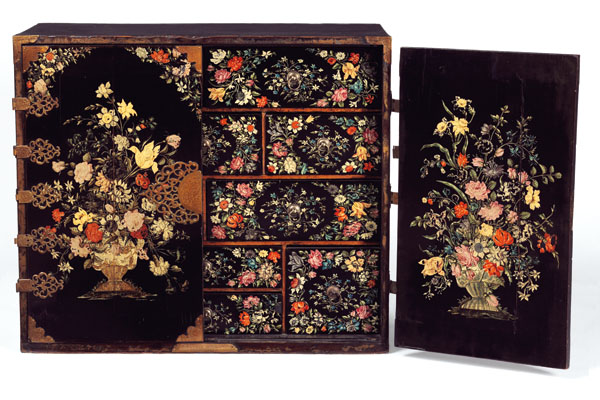The Holburne Museum of Bath is a delight. Its collections were formed by Sir William Holburne (1793–1874), a naval officer who first saw action at the Battle of Trafalgar at the age of 12 and retired to Bath in 1820 to dedicate his celibate life — he shared his house with his three sisters — mostly to travel and collecting. Since 1912, his collections have been housed in a beautiful neoclassical building, originally built as a hotel in the 1790s and situated at the end of Great Pultney Street. They include Imari porcelain, Maiolica pottery, Augsburg silver and Dutch 17th-century landscapes, as well as curios such as a spur, purportedly used by the Duke of Monmouth at the Battle of Sedgemoor (1685). Given their somewhat conservative nature, they provide a unique insight into the contents of those splendid 18th-century houses, with which Jane Austen would have been familiar.
Secret Splendour takes one into the world of the 17th-century collector and how he housed and displayed his collections. These he would place in his most swanky piece of furniture, the cabinet, which he would have had decorated with tortoiseshell, embossed silver, inlaid tropical woods, or painted and japanned in the oriental style. The most expensive cabinets were imported from Japan or China, but they were also made all over Europe, particularly in Augsburg, Antwerp, Eger, Paris, Naples and even London, and it is the European cabinet in all its varied forms that is on show in this exhibition.
Secret Splendour consists of 13 cabinets, dating from about 1600 to 1700: three come from the Holburne Collection, and the remainder are on loan, mostly from the Victoria & Albert Museum. The star item from the ‘home team’ is a yellow (or rather discoloured white) japanned cabinet, acquired from Witcombe Park in Gloucestershire, probably made in London and painted with motifs inspired by Chinese porcelain. Rare for a cabinet of this nature, it retains its original silvered stand and cresting, which is fitted with small shelves on which to place porcelain vases.
One can see such V&A favourites as the Neapolitan cabinet with painted glass panels, the Parisian ebony cabinet, which depicts the story of Diana and Endymion, and a shallow-relief carved cabinet from Eger (now Cheb in the Czech Republic). Cabinets should be — and in this case they are — opened up to reveal their full splendour inside. There was meant to be something theatrical about the way the host led his visitor to a solid, glorified box and then opened it up with a flourish to startle his guest with the sight of his most prized objects arranged inside. The idea of theatre is reinforced by constructing the inside drawers round a miniature stage, often fitted with a chequerboard floor and walls of mirrored glass, cleverly arranged to create various optical illusions from different viewpoints.
It is particularly gratifying when one of the cabinets, part of the original Holburne collection, makes a Cinderella-like transformation from a neglected and much-altered item languishing in storage into one of the main attractions of the exhibition. Crowned with a cascade of tropical shells, corals and semi-precious stones, this cabinet has been beautifully arranged with various objects inside, much like a 17th-century Dutch still life. It is opened up between 11.30 and 3.30 each day so that visitors can learn what sort of things were collected and even handle selected items.
Any serious collector of curiosities would have divided them between man-made and natural objects. Oriental porcelain vases and sandalwood fans, Roman coins, Italian miniature bronzes and Egyptian amulets would vie for one’s attention with lumps of amber or coral, nautilus shells, or dried cowfish and ‘Jenny Hanivers’, which were dried skate or ray fish sold as preserved mermen — not very savoury perhaps, but collectors were seldom squeamish: John Aubrey referred to a kidney, extracted from the body of Father William Harcourt after his execution at Tyburn in 1679, which later petrified ‘like an Agate polished’.
This is an exhibition where you can concentrate on the objects in front of you, rather than undergo death by interactive computer displays or didactic panels — mercifully, there are none of the former and only two of the latter, and both the text and illustrations are very much to the point. There is also a concise catalogue. Do stay for the talk round the specially arranged cabinet, and you will come away much better informed about how 17th-century collections — and ultimately modern museums — were formed.






Comments